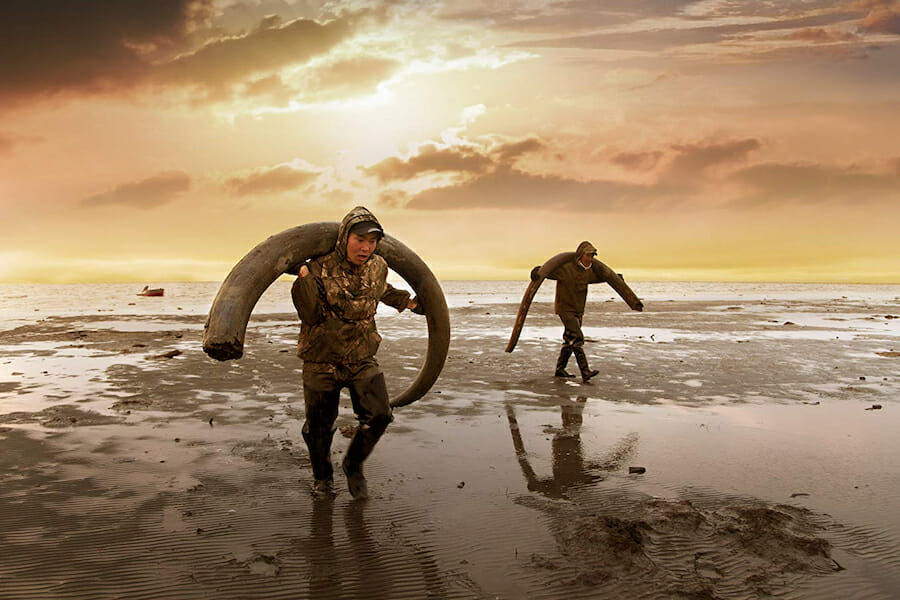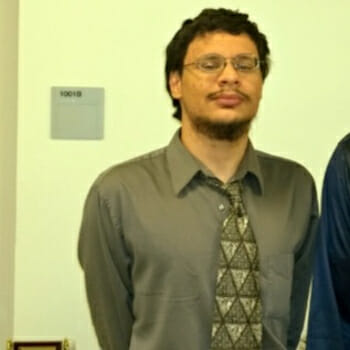
‘Genesis 2.0’: Pursuit of the Wooly Mammoth
Behold an expedition of mammoth proportions…Genesis 2.0 is a documentary that follows two groups of people united by their passionate pursuit of one thing: the wooly mammoth. The film simultaneously explores the paleontology team of mammoth expert Semyon Grigoriev and a team of blue-collar Yakut Siberians who travel to the New Siberian Islands in search of mammoth tusks. Semyon himself traveled to the uninhabited Arctic islands in 2013 to retrieve the most intact mammoth corpse ever discovered.
Semyon’s expedition footage is both awe-inspiring and creepy. The mammoth was so well preserved by the Arctic cold that it bleeds when punctured. We are treated to unprecedented images of mammoth wool clumps, tusk flesh and an intact front left leg-and-neck bone section that towers over the scientists. The film does a good job of relaying some native Yakut culture, especially in regards to the mammoth. Semyon and his fellow team members conclude their excavation of the mammoth with a ritual to honor the pachyderm’s spirit. The Yakut consider it bad luck to disrupt the remains of a mammoth, in its spirit’s resting place.
The tusk hunters descend upon the islands every warm season in search of mammoth ivory. Their motive is much less idealistic than that of Semyon; money. Since elephant ivory was outlawed globally, mammoth ivory has skyrocketed in value; an artistically carved mammoth tusk can fetch up to $1 million. This prohibition was great for elephant well-being but has compelled many financially desperate people to risk their lives every year. Travel to the island takes two days by boat; the stormy waters generally claim at least one boat a season. Starvation is also a daily concern on the barren archipelago. Perhaps the biggest threat of all is the sheer social isolation. The male prospectors are forced to leave their loved ones for months on end…in a woman-less land. Outside contact is limited to one phone call a season for each man. Fossil hunting itself is quite maddening: hour after hour of just poking around the soil with bayonets and generally walking away empty handed.
The film briefly spotlights the efforts of renowned Harvard geneticist George Church. He wants to introduce mammoth genes into an elephant embryo to create a hybrid. Semyon Grigoriev has the much more ambitious goal of creating a mammoth clone. We follow him on this mission as he travels to Sooam Biotech, a cloning institute in Seoul that has successfully cloned about 1,000 dogs. Cloning rich people’s pooches for $100k a pop subsidizes Sooam’s research, which includes trying to find a living mammoth cell in Semyon’s samples to begin the cloning process. Sooam is run by Huang Woo-suk, a controversial scientist who achieved infamy for faking research results about cloning human stem cells
Semyon then travels to Beijing Genomics Institute (BGI) in Shenzhen. This mammoth facility, which has funded itself by screening the genomes of about 2 million women’s fetuses for congenital defects, is trying to sequence the genome of every species on Earth. Semyon will need BGI to sequence the mammoth genome as part of the theoretical cloning process. Every genome on Earth is made up of four nucleotides, A, C, G and T. (Fun fact: humans and pumpkins are 75% genetically similar). While touring BGI, members of Semyon’s team discuss the possible bioethical concerns with the staff members. The BGI spokeswoman deflects several times, including a time when she answers a Swedish scientist’s question about the ethics of eliminating Down Syndrome fetuses via screening with silence and an uncomfortable smirk. The film notes that BGI has ties to both the Communist Party and the Chinese army, which points a possible future of the weaponization of the human genome for military and population control purposes.
Genesis 2.0 is a fascinating look at the life and work of Siberia’s wooly mammoth workers. We are treated to a behind-the-scenes look at paleontology excavation and genetics research. Just as fascinating is the exploration into the psyches of the workers themselves. Maxim Arbugaev and Christian Frei do a good job of documenting the hopes, dreams, and despair of the scientists and fossil hunters. The fossil hunter Spira embodies the highs and lows of the industry: he’s risking his life to wipe out a personal debt and thus secure his family’s future. Over time, he falls into a deep despair while hunting the perfect tusk. Narrator Maxim Arbugaev notes that “The beauty of this place is dangerous.” The cinematography is indeed beautiful: a cavalcade of austere panorama shots of an otherworldly archipelago seldom seen by man. When paired with the film’s score, it creates a genuine appreciation for Russia’s Sanga Sibiir. Arbugaev and Frei likewise let the audience appreciate the breadth of the ethical quandaries of cloning and bioengineering. The film isn’t too preachy but rather lets us imagine the ramifications of what the scientists are doing and debating.
